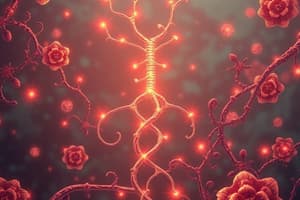Podcast
Questions and Answers
What is the main focus of the subfield of biophysics known as cellular mechanics?
What is the main focus of the subfield of biophysics known as cellular mechanics?
- Understanding the genetic code of cells
- Analyzing the electrical impulses in cells
- Investigating the chemical composition of cells
- Studying the mechanical properties and behavior of cells (correct)
What is cellular stiffness a measure of?
What is cellular stiffness a measure of?
- The ability of a cell to resist deformation under external forces (correct)
- The ability of a cell to change shape
- The ability of a cell to divide rapidly
- The ability of a cell to move quickly
What technique is used to measure the forces exerted by cells on their surroundings?
What technique is used to measure the forces exerted by cells on their surroundings?
- Traction force microscopy (TFM) (correct)
- Rheometry
- Micropipette aspiration
- Atomic force microscopy (AFM)
Which cell type exhibits high stiffness and is highly resistant to deformation?
Which cell type exhibits high stiffness and is highly resistant to deformation?
What is cellular rheology the study of?
What is cellular rheology the study of?
Which technique uses a sharp probe to measure cellular stiffness and topography?
Which technique uses a sharp probe to measure cellular stiffness and topography?
What is the term for cells exhibiting time-dependent behavior under stress?
What is the term for cells exhibiting time-dependent behavior under stress?
What is a potential application of understanding cellular mechanics?
What is a potential application of understanding cellular mechanics?
Flashcards are hidden until you start studying
Study Notes
Cellular Mechanics
Introduction
- Biophysics is an interdisciplinary field that applies physical principles and methods to understand biological systems
- Cellular mechanics is a subfield of biophysics that focuses on the mechanical properties and behavior of cells
Key Concepts
- Cellular stiffness: the ability of a cell to resist deformation under external forces
- Measured using techniques such as atomic force microscopy (AFM) and micropipette aspiration
- Cellular rheology: the study of the mechanical behavior of cells under different conditions (e.g. stress, strain, frequency)
- Uses techniques such as rheometry and optical tweezers
- Cellular traction forces: the forces exerted by cells on their surroundings
- Measured using techniques such as traction force microscopy (TFM)
Mechanical Properties of Cells
- Elasticity: cells exhibit elastic behavior under small deformations
- Viscoelasticity: cells exhibit time-dependent behavior under stress, exhibiting both elastic and viscous properties
- Nonlinear behavior: cells exhibit nonlinear behavior under large deformations
Cellular Mechanics in Different Cell Types
- Epithelial cells: exhibit high stiffness and are highly resistant to deformation
- Endothelial cells: exhibit lower stiffness and are more prone to deformation
- Cancer cells: exhibit altered mechanical properties, such as increased stiffness and invasiveness
Techniques for Measuring Cellular Mechanics
- Atomic force microscopy (AFM): uses a sharp probe to measure cellular stiffness and topography
- Micropipette aspiration: uses a glass pipette to measure cellular stiffness and deformability
- Rheometry: measures the mechanical behavior of cells under different conditions
- Optical tweezers: uses focused laser light to measure cellular stiffness and manipulate cells
- Traction force microscopy (TFM): measures the forces exerted by cells on their surroundings
Applications of Cellular Mechanics
- Cancer research: understanding the mechanical properties of cancer cells can inform the development of new treatments
- Tissue engineering: understanding the mechanical properties of cells can inform the design of biomaterials and tissue constructs
- Wound healing: understanding the mechanical properties of cells can inform the development of new treatments for wound healing
Cellular Mechanics
Definition and Scope
- Biophysics is an interdisciplinary field that combines physical principles and methods to understand biological systems
- Cellular mechanics is a subfield of biophysics that focuses on the mechanical properties and behavior of cells
Key Concepts
- Cellular stiffness: the ability of a cell to resist deformation under external forces, measured using atomic force microscopy (AFM) and micropipette aspiration
- Cellular rheology: the study of the mechanical behavior of cells under different conditions (e.g. stress, strain, frequency), using techniques such as rheometry and optical tweezers
- Cellular traction forces: the forces exerted by cells on their surroundings, measured using traction force microscopy (TFM)
Mechanical Properties of Cells
- Elasticity: cells exhibit elastic behavior under small deformations
- Viscoelasticity: cells exhibit time-dependent behavior under stress, exhibiting both elastic and viscous properties
- Nonlinear behavior: cells exhibit nonlinear behavior under large deformations
Cellular Mechanics in Different Cell Types
- Epithelial cells: exhibit high stiffness and are highly resistant to deformation
- Endothelial cells: exhibit lower stiffness and are more prone to deformation
- Cancer cells: exhibit altered mechanical properties, such as increased stiffness and invasiveness
Measurement Techniques
- Atomic force microscopy (AFM): measures cellular stiffness and topography
- Micropipette aspiration: measures cellular stiffness and deformability
- Rheometry: measures the mechanical behavior of cells under different conditions
- Optical tweezers: measures cellular stiffness and manipulates cells
- Traction force microscopy (TFM): measures the forces exerted by cells on their surroundings
Applications
- Cancer research: understanding cellular mechanics can inform the development of new treatments
- Tissue engineering: understanding cellular mechanics can inform the design of biomaterials and tissue constructs
- Wound healing: understanding cellular mechanics can inform the development of new treatments for wound healing
Studying That Suits You
Use AI to generate personalized quizzes and flashcards to suit your learning preferences.




